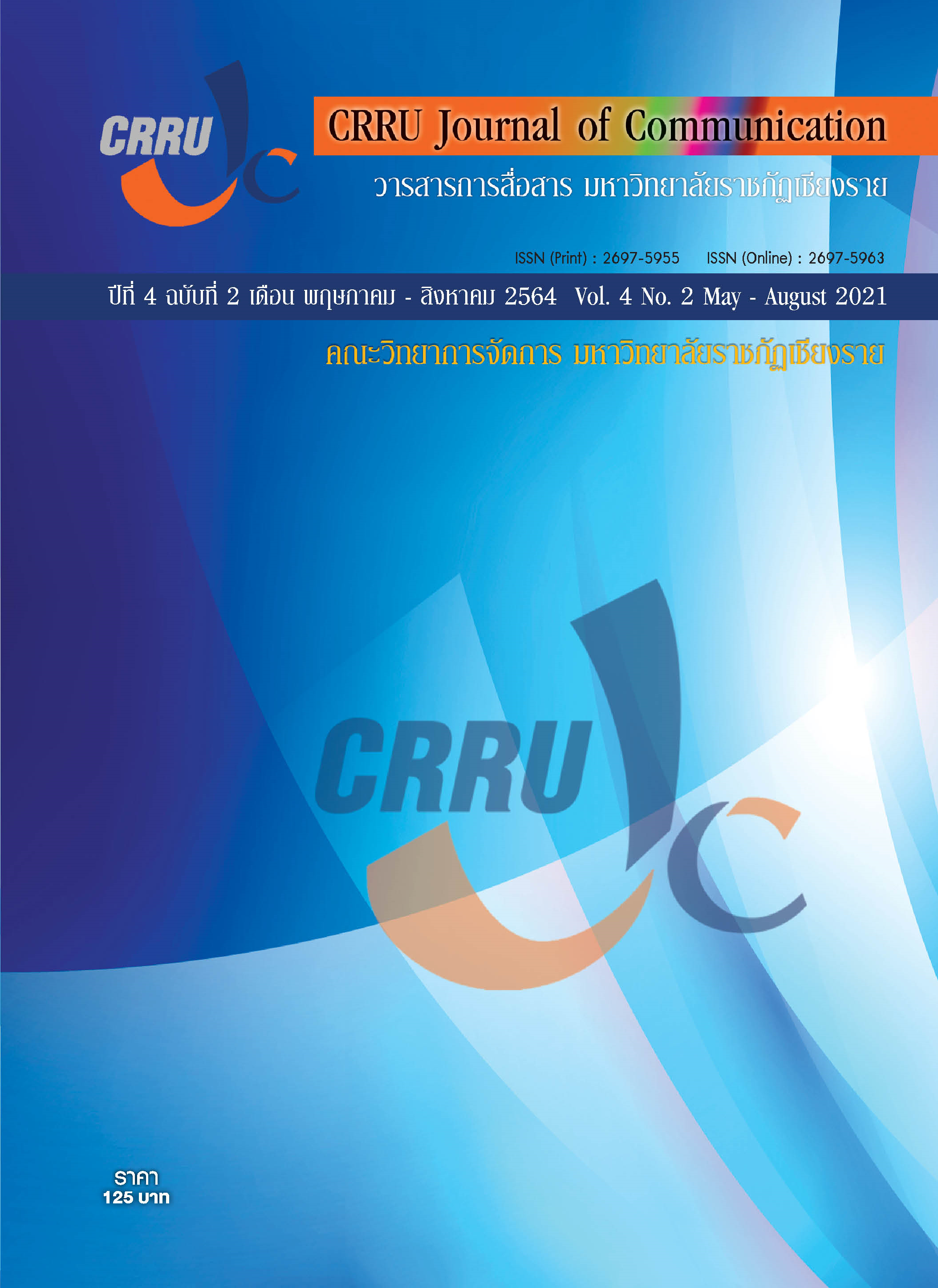Reputation Crisis: Crisis Management for Sustainable Corporate Reputation Protection
Main Article Content
Abstract
This article has two objectives. Firstly, to study basic knowledge of concepts, theories, and research on reputation crises. Secondly, to present the current business enterprise reputation crisis management guidelines. By discussing the phenomenon from the results of relevant research on the meaning, the impact of reputation crisis and corporate reputation crisis management guidelines, to lead to effective management of corporate reputation crisis. This paper presents five key ways to address crisis management related to reputation as follows; 1) predicting a reputation crisis 2) reputation risk management 3) reputation crisis management 4) reputation risks and crises communication and 5) building a strong reputation. This reputation crisis management approach can reduce the opportunity and deal with the reputation crisis more effectively. Including building a strong reputation for the stability of the corporate reputation in the long term.
Article Details
References
นงลักษณ์ โชติวิทยธานินทร์. (2559). กลยุทธ์การจัดการชื่อเสียงของมหาวิทยาลัยราชภัฏ. วิทยานิพนธ์ปริญญาดุษฎีบัณฑิต, คณะนิเทศศาสตร์ จุฬาลงกรณ์มหาวิทยาลัย.
รุ่งนภา พิตรปรีชา. (2552). ปัจจัยสะท้อนความมีชื่อเสียงของธุรกิจโทรคมนาคมในประเทศไทย. (งานวิจัย). คณะนิเทศศาสตร์ จุฬาลงกรณ์มหาวิทยาลัย.
รุ่งนภา พิตรปรีชา. (2553). ตัวชี้วัดความมีชื่อเสียงของธุรกิจเอกชนในประเทศไทย. (งานวิจัย). คณะนิเทศศาสตร์ จุฬาลงกรณ์มหาวิทยาลัย.
Ayse Kucuk Yilmaz and Ferziye Kucuk. (2010). The Reputation Crisis: Risk Management Based Logical Framework to the Corporate Sustainability, Process Management, MariaPomffyova (Ed.), ISBN: 978-953-307-085-8, 223-244.
An-Sofie Claeys and Verolien Cauberghe. (2015). The role of a favorable pre-crisis reputation in protecting organizations during crises. Public Relations Review. 41(1), 64-71.
Barbara Reynolds. (2002). Crisis and Emergency Risk Communication. Centers for Disease Control and Prevention (CDC).
Caywood, Clark L. (1997). The Handbook of Strategic Public Relations & Integrated Communications. McGraw-Hill Companies, NY.
Coombs, W. T. (2006). The protective powers of crisis response strategies: Managing reputational assets during a crisis. Journal of Promotion Management, 12 (3/4), 241-260. doi:10.1300/J057v12n03_13
Coombs, W. T. (2007a). An occurrence of crisis communication: planning, managing, and responding (2nd ed.). Thousand Oaks, CA: Sage.
Coombs,W. T., & Holladay, S. J.(2006). Unpacking the halo effect: Reputation and crisis management. Journal of Communication Management, 10(2), 123–137.
Coombs, W. T. (2015). Ongoing crisis communication planning, managing, and responding (4 ed.). Thousand Oaks, California: SAGE Publications, Inc.
Deephouse, D. L. (2000). Media reputation as a strategic resource: An integration of mass communication and resource-based theories. Journal of management, 26(6), 1091-1112.
Dowling, G. R. (2001). Create Corporate Reputation: Identity, Image and Performance. Oxford University Press. New York.
Dutta, S., & Pullig, C. (2011). Effectiveness of corporate responses to brand crises: The role of crisis type and response strategies. Journal of Business Research, 64(12), 1281–1287.
Eisenegger, M., & Schranz, M. (2011). Reputation management and corporate social responsibility. In Ø. Ihlen, J.
Bartlett, & S. Mays (Eds.), Handbook of communication and corporate social responsibility. Oxford: Wiley Blackwell
E. L. Quarantelli. (1988). Disaster Crisis Management: A Summary Of Research Findings. Journal of Management Studies, 25(4), 373-385.
Fombrun, C. J. (1996). Reputation: Realizing Value from the Corporate Image. Boston, USA: Havard Business School Press.
Gaultier-Gaillard, S.; Louisot, J P. (2006). Risks to Reputation: A Global Approach. The Geneva Papers on Risk and Insurance. Palgrave Macmillan Journals, 31(3), 425–445.
Griffin, A. (2014). Crisis, issues and reputation management: A handbook for PR and communications professionals. London: Kogan Page.
Joosub, T.S. (2006). Risk Management Strategies to Maintain Corporate Reputation. Master Thesis. Master of Commerce. Business Management. University of South Africa.
Kasper Ulf Nielsen. (2015). Reputation Risk in a Social Media Culture: How well is the insurance market responding, New Generation Programme. Broking Faculty.
Larkin J. (2003). Strategic Reputation. Palgrave Macmillan, USA, 37-86.
Laurence Barton, L. (1993). Crisis in organizations: managing and communication in the heat of chaos. Cincinnati, Ohio: SOUTH-WESTREN Publishing.
Miglo’ Šontaito’-Petkeviþieno’. (2014). Crisis management to avoid damage for corporate reputation: The case of retail chain crisis in the Baltic countries. Procedia - Social and Behavioral Sciences. 156, 452 – 457.
Minor, D., & Morgan, J. (2011). CSR as reputation insurance: Primum non nocere. California Management Review, 53(3), 40–59.
Morley, M. (1998). How to Manage Your Global Reputation. MacMillan. UK: Basingstoke.
National Response Plan (2005). Emergency Planning: National Response Plan. Retrieved Auguse 16, 2005, from http://www.dhs.gov/dhspublic/interapp/editorial/ editorial_0566.xml.
Nicolas Georges Trad, Michele Tesoro-Tess, Zachey Kliger. (2017). Managing Reputation Risk. Key Insights from the Reputation Risk Study, info@reputationinstitute.com, https://www.reputationinstitute.com/research/ managing-reputation-risk.
Rayner, (2004). Managing Reputational Risk, APM/IRM, Manchester, 5th February 2004, Abbey Consulting. Retrieved 10/30/2009 from http://www.theirm.org/events/documents/managing_reputational_risk_jrayner. pdf.
Reynolds, B. & Seeger, M. W. (2005). Crisis and emergency risk communication as an integrativemodel. Journal of Health Communication, 10, 43-55. doi:10.1080/10810730590904571
Regan, L. (2008). A Framework for Integrating Reputation Risk into the Enterprise Risk Management Process. Journal of Financial Transformation, 22, 187-194.
Reynolds, B. (2002). Crisis and emergency risk communication. Atlanta, GA: Centers for Disease Control and Prevention.
Sergio Scandizzo. (2011). A framework for the analysis of reputation risk. The Journal of Operational Risk, 6(3), 41–63.
Sophie Gaultier-Gaillard, Jean-Paul Louisot, Jenny Rayner. (2009). Managing reputational risk – From theory to practice. Reputation Capital. Building and Maintaining Trust in the 21st Century.
Stefan Aerts. (2013). Applying the CERC model within the context of extreme weather: A study about the influence ofThe timing and efficacy beliefs on information seeking and self-protective behaviors. Master Thesis. University of Twente.
Stelios Zyglidopoulos, Nelson Phillips. (1999). Responding to Reputational Crises:
A Stakeholder Perspective. Corporate Reputation Review, 2(4), 322-350.
Taylor, K. E. (2001). Summarize multiple aspects of model performance in a single diagram. Journal Geophys Research, 106, (June 2001), 7183-7192.
Weiner, D. (2006). Crisis Communications: Managing Corporate Reputation in the Court of Public opinion. Ivey Business Journal, 3(4), 1-6.
Wilcox D. (1994). Community participation and empowerment: putting theory into practice.
Yoon, Y., Gürhan-Canli, Z., & Schwartz, N. (2006). The effect of corporate social responsibility activities on companies with bad reputations. Journal of Consumer Psychology, 16(4), 377–390.


